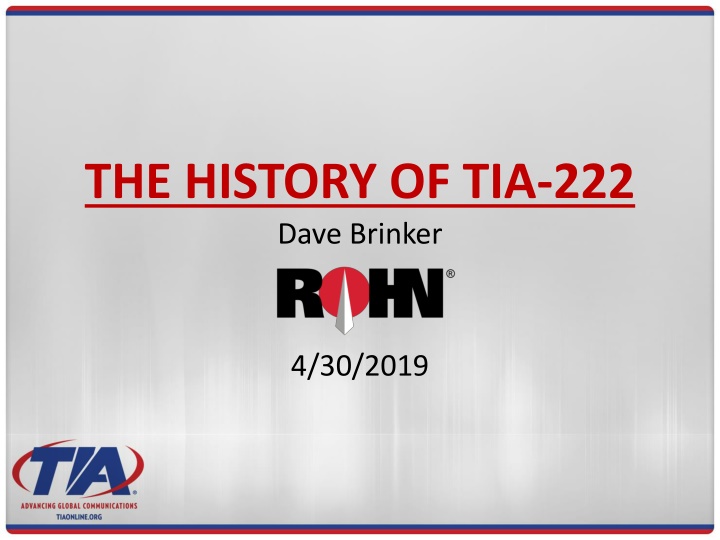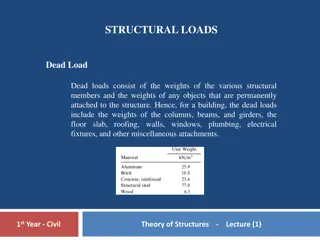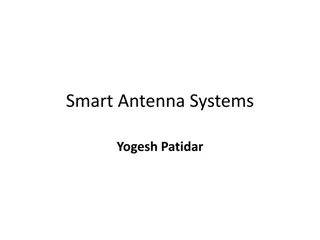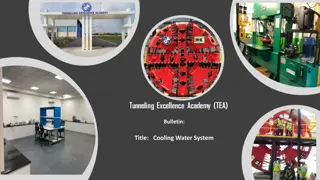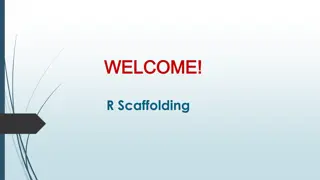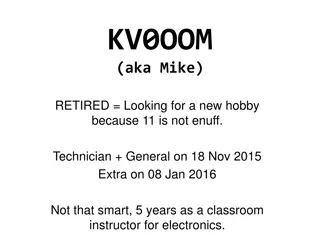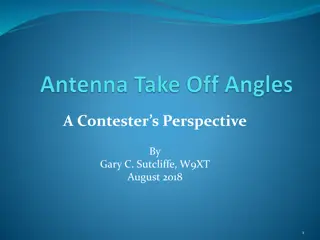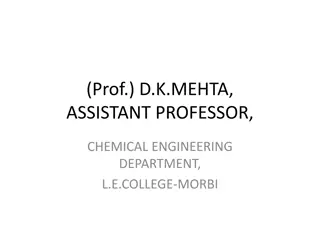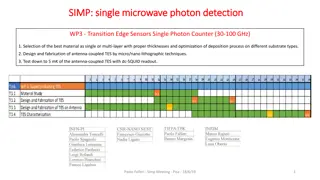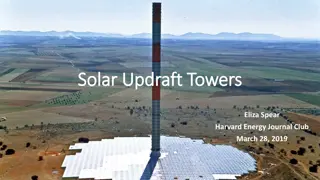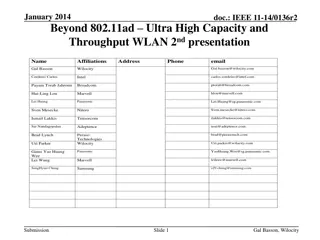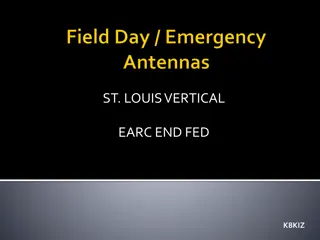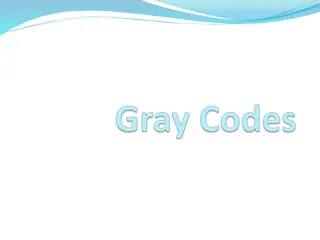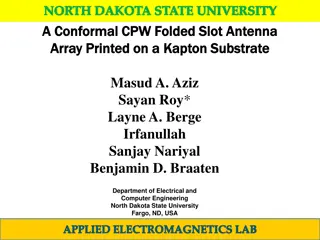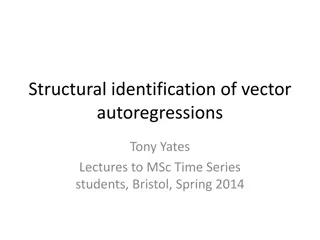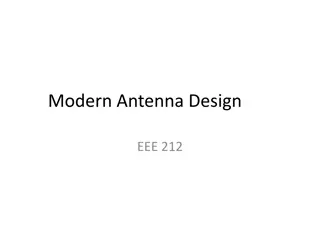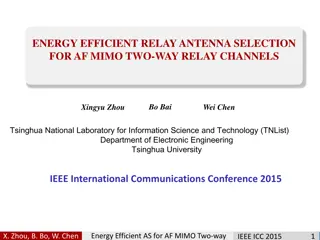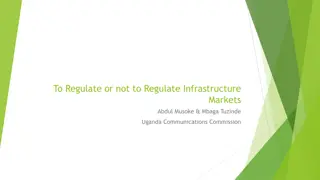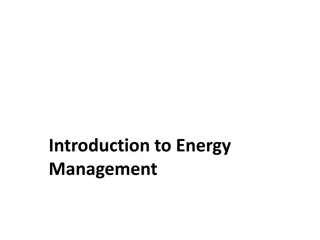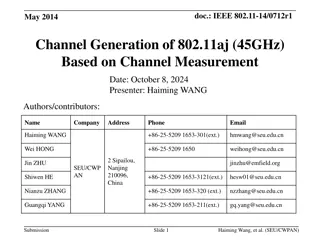Evolution of Structural Standards for Antenna Towers and Supporting Structures
The history of TIA-222 and its development through various industry groups led to the establishment of structural standards for steel antenna towers and supporting structures. Starting from TR-116 in 1949 to the latest ANSI/TIA-222-H in 2017, these published standards have evolved to ensure safety and reliability in the construction of antenna systems. Major features of these standards include shape factors, wind load requirements, soil specifications, and more.
Download Presentation

Please find below an Image/Link to download the presentation.
The content on the website is provided AS IS for your information and personal use only. It may not be sold, licensed, or shared on other websites without obtaining consent from the author.If you encounter any issues during the download, it is possible that the publisher has removed the file from their server.
You are allowed to download the files provided on this website for personal or commercial use, subject to the condition that they are used lawfully. All files are the property of their respective owners.
The content on the website is provided AS IS for your information and personal use only. It may not be sold, licensed, or shared on other websites without obtaining consent from the author.
E N D
Presentation Transcript
THE HISTORY OF TIA-222 Dave Brinker 4/30/2019
SPONSORING INDUSTRY GROUPS RMA - Radio Manufacturers Association, 1924 RTMA - Radio-Television Manufacturers Association, 1950 RETMA - Radio-Electronics-Television Manufacturers Association, 1953 EIA - Electronic Industries Association, 1957 TIA/EIA - Merger forming the Telecommunications Industry Association, 1988 TIA - Telecommunications Industry Association, 2005
PUBLISHED STANDARDS TR-116 Radio Transmitting Antennas and Supporting Towers for Radio Transmitting Antennas, 1949 RS-194 Microwave Relay System Towers (Supplement to TR-116), 1957 RS-222 Structural Standards for Steel Transmitting Antennas, Supporting Steel Towers (combined TR-116 & RS-194), 1959 RS-222-A Structural Standards for Steel Antenna Towers and Antenna Supporting Structures, 1966 RS-222-B Structural Standards for Steel Antenna Towers and Antenna Supporting Structures, 1972 RS-222-C Structural Standards for Steel Antenna Towers and Antenna Supporting Structures, 1976
PUBLISHED STANDARDS (continued) ANSI/EIA-222-D Structural Standards for Steel Antenna Towers and Antenna Supporting Structures, 1986 ANSI/EIA/TIA-222-E Structural Standards for Steel Antenna Towers and Antenna Supporting Structures, 1991 ANSI/TIA/EIA-222-F Structural Standards for Steel Antenna Towers and Antenna Supporting Structures, 1996 ANSI/TIA-222-G Structural Standard for Antenna Supporting Structures and Antennas, 2005 (G-1, G-2, G-3, G-4) ANSI/TIA-222-H Structural Standard for Antenna Supporting Structures, Antennas and Small Wind Turbine Support Structures, 2017
MAJOR FEATURES TR-116, 1949 4 pages $0.25 1.5/1.75 shape factor triangular/square towers 1.0 shape factor for closed face (solid) 20 psf up to 600 ft structures, non-city location 30 psf over 600 ft structures, all city locations 2/3 reduction for cylindrical surfaces 4,000 psf standard soil, 30 degree uplift cone Hot dip galvanizing not required
MAJOR FEATURES RS-194, 1957 Minimum wind load changed to 30 psf Wind pressure 0.0040V^2 (2/3 reduction for rounds) Sway, twist and displacement limits at 20 psf Factor of safety of guys equal to 2.5 Protective grounding
MAJOR FEATURES RS-222, 1959 Combined two previous standards Wind zones A, B & C introduced Wind pressures varied with height with pressures from 30 to 70 psf First wind zone map Displacement at guy levels required to be considered
MAJOR FEATURES RS-222-A, 1966 New wind zone map Wind required on windward and leeward guys Minimum 1/2 inch of ice required when ice is considered Ice applied concurrent with wind on structure and guys Reference to AISC with no 1/3 increase in allowable stresses High strength bolts introduced Hot-dip galvanizing required for material less than 3/16 inch
MAJOR FEATURES RS-222-B, 1972 Higher uniform wind pressures (50-85 psf) for towers 651 ft and higher Removed 1/2 inch minimum ice requirement First sketches of ice accumulation treated as cylindrical surfaces First recognition of reduced loading with multiple antennas at an elevation Snug tight bolts with a nut-locking device Term Normal Soil introduced Added lateral 400 psf/ft soil strength, 4,000 psf max Installation tolerances introduced (plumb & linearity) First mention of climbing facilities (250 pound load)
MAJOR FEATURES RS-222-C, 1976 Ice to be considered when known to occur with wind No minimum ice thickness Design wind vs. withstand & survival addressed Climbing and working facility criteria added (loading & dimensions) Safety climbs not mandatory but if used, must meet ANSI A14.3
MAJOR FEATURES ANSI/EIA-222-D, 1986 Acceptance by ANSI, UBC, BOCA & SBC, SI units ASCE 7 fastest-mile wind criteria vs. pressure Wind pressure equation (0.00256 vs. 0.0040) Exposure C without wind speed-up Reduced wind load with ice Operational = 50% of 70 mph min strength loading = 50 mph Effective projected areas (lines, appurtenances, structure) Solidity ratio for latticed structures (w/ symmetrical appurtenances) Lift and drag factors for guys
MAJOR FEATURES ANSI/EIA-222-D, 1986 (Continued) Buckling considerations between guy levels 1.5% redundant strength requirement 1/3 increase in allowable stresses for structures under 700 ft 2.0 guy safety factor for structures under 700 ft Effective slenderness of angles Factor of safety for foundation self weight vs. soil strength Maintenance, inspection and analysis of existing structures Purchaser checklist introduced
MAJOR FEATURES ANSI/EIA/TIA-222-E, 1991 Return of the county listing Ice loading criteria annex Pole criteria, gust factors, drag factors, allowable stresses Double angle out-of-plane slenderness Hot-dip galvanizing default finish for all material thicknesses Geotechnical considerations annex
MAJOR FEATURES ANSI/TIA/TIA-222-F, 1996 Pole drag factors increased to account for attachments Appurtenances must be considered to remain intact on structure Corrosion control for guy anchors annex Ice considered to fill gaps between lines
MAJOR FEATURES ANSI/TIA-222-G, 2006 Conversion from ASD to LRFD Fastest-mile to 3-second gust (50-yr return) Structure classes, exposures, wind speed-up Added analysis section, patch loading, guy rupture Separated appurtenances in solidity ratio for tower Ice map, different model for ice weight Earthquake criteria Wind loading for mounting arrangements, shielding, line clusters
MAJOR FEATURES ANSI/TIA-222-G, 2006 (continued) Prequalified materials & use of other than steel Increased pole strengths Min leg splice strength for guyed masts Redundants (1.5 to 2.5 percent) Guy assemblies, dampers, articulation, insulators Grounding, first ground resistance specified Existing structures, changed conditions, exemptions Climber safety, safety climbs, attachment points Corrosion control expanded Small wind turbine support structures, fatigue
MAJOR FEATURES ANSI/TIA-222-H, 2017 Ultimate wind, ice and earthquake criteria Global stability Site-specific exposures and topographic features Expanded reliability classes (hardened networks) Increased angle strengths Foundation and anchorages additions Climber safety, factored loading, step bolt criteria
MAJOR FEATURES ANSI/TIA-222-H, 2017 (continued) Mount design and analysis criteria Guy anchor corrosion management plan Pole drag factors, base plate design, toe cracks Grounding system, focus on impedance, reduced ground wire diameter Existing structure criteria expanded (changed conditions, 1.05 demand-capacity ratio, assumed material standards, target reliabilities) Pre and post construction inspections, including modifications Wind induced oscillations annex
TOP 10 BATTLES #1 Mandatory ice loading #2 ASD to LRFD #3 Use of 1/3 increase in stresses #4 Exposure C as minimum requirement #5 Existing structures #6 Angle member strength #7 Treatment of appurtenances #8 Earthquake loading #9 Grounding #10 Anchor rod corrosion Lessons Learned: 1. Keep efforts focused on the Industry & everyone wins. 2. If our Industry does not govern itself, someone else less informed will. 3. It is not an exact science but an evolving, continuous process of improvement. HAPPY ANNIVERSARY!!
